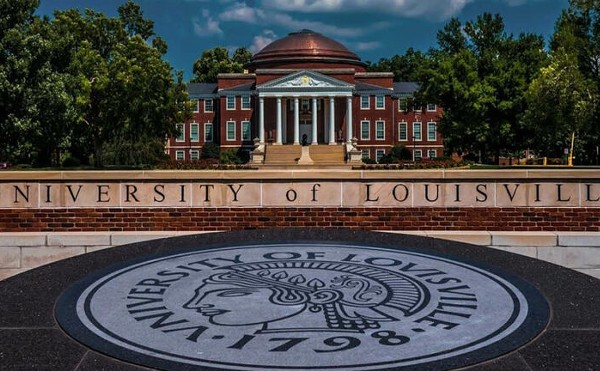The universal joke of No Child Left Behind, President Bush’s major education initiative that’s been law for four years now, is in its rhetoric: the very title carries such an impossible, absurd implication, particularly when you consider how the act has come to manifest itself in American public schools. Its major contribution to the cultural enrichment of America’s youth has been to dramatically raise standards — for reading and math — by way of a one-size-fits-all mode of standardized testing.
Schools nationwide have been backed against the proverbial wall: It’s a black and white, put-up-or-shut-up standard whose basic tenet holds that, if nothing else, public school students must escape grade 12 with at least math and reading skills. OK.
Yet because the program is grossly underfunded, it has become a drag on morale that also appears to be systematically excising creativity and interdisciplinary learning from the Great American Classroom.
That’s according to “From the Capital to the Classroom,” the hefty fourth annual survey of NCLB by an independent public education advocate called the Center on Education Policy, based in Washington, D.C. The number the survey provides is staggering: 71 percent of the 15,000 U.S. school districts have reduced class time spent on subjects like history, music, social studies and science to prepare students to meet the math and reading standards on their NCLB assessments. California, Colorado, Texas, Vermont and Nebraska, among other states, are experiencing significant curriculum shifts. (Departments of Education completed the survey for each state; Kentucky’s portion was not available at press time, as the official who completed it was on vacation and could not be reached.)
It’s like a marathon where every water bottle you’re given along the way is empty, and yet you’re expected to keep running, to finish. Such a race mentality for public schools, complete with “corrective action” ultimatums, is exactly what’s required to stay on the federal dole. And many say it’s crushing the very spirit of public education.
Here in Jefferson County, things seem to be following the national trend, although it’s fair to say we’ve always been hard on people who can’t read or add.
Jacqueline Austin, director of curriculum and assessment for Jefferson County Public Schools, said the curriculum hasn’t been changed so much as just tweaked.
“I wouldn’t say has really reduced our curriculum, because we’ve always had a focus on math and reading,” she said. “We had to put some strategies in place for even our math teachers to focus on reading .”
Austin said JCPS has nine core disciplines: science, reading, writing, math, social studies, arts and humanities, practical living (health), music and world language.
With regard to Core Content, the state’s term for its own standards, nothing has changed. NCLB is a high-stakes accountability system, as is Kentucky’s CATS (Commonwealth Accountability Testing System), which has been in place since 1992. This year’s CATS test begins April 17.
The only direct change the state made in response to NCLB was to add testing at some lower grade levels.
Kentucky’s CATS standards actually test in seven core areas, rather than just the two. The federal government uses the reading and math data from CATS to measure the state’s proficiency in NCLB terms.
Brent McKim, president of the Jefferson County Teachers’ Association, is dismayed by the change he’s seen in what’s being taught.
“I think there have been significant shifts in instructional time from other non-assessed subjects toward subjects that are assessed or expected to soon be assessed,” he said.
The introduction of the Every 1 Reads program, a community-interactive reading initiative designed to bring every JCPS student to grade level reading by 2008, is perhaps the most high-profile example of what McKim is talking about.
At the state level, a new math requirement was added for high school graduation. Likewise, most of the discourse involving changing public school curriculums is centered on the NCLB requirements.
“I don’t have any doubt that schools are focusing more attention on reading and math than they did before, and they may be excluding other subjects because they’re not held accountable for those subjects,” said Lisa Gross, a spokesperson for the state Department of Education.
The real question isn’t so much whether that’s a bad thing — everybody pretty much agrees that it is. However, they still have to do it.
The CEP survey also found that, while the general public is nearly split on how it views NCLB — as well as how much the average American actually understands it — some 75 percent of teachers don’t like it.
“I think it’s having a devastatingly negative effect on teachers and morale, but more importantly on instructional practice,” said McKim, a physics teacher at DuPont Manual High School who’s on leave for his current position. “The approach that NCLB takes is to, in a very high stakes way, potentially grade students and schools, and therefore indirectly teachers, based on one test in one day on two subjects. That’s terribly problematic in and of itself.”
The notion of a cheap (read: inexpensive to buy and grade) standardized test as the golden ticket to federal dollars is absurd to McKim, and by extension to many teachers, whose value lies in their ability to actually teach concepts and ideas, not just how to pass a test. Yet public schools are becoming, in some ways, like the stereotypical jack-off college students who study just to get through tests.
“It doesn’t teach high order skills,” he said of the testing system. “Just learning really simple rote mathematical procedures and equations is not interesting in and of itself. It’s dry as the Sahara Desert. But if you’re talking about things of a higher order, there’s an innate need on the part of the students to learn the basic needs to get to that higher order.”
He was talking about interactive learning, problem solving in the real world sense, which is basically a constant exam of connectivity and interdisciplinary skills. It illuminates a set of skills the American public education system at-large has been accused of leaving behind. Consider negotiating the purchase of a car, and count on both hands the number of individual subjects you’d be accessing were you in, say, sixth grade. It stands to reason that such an approach to learning should be cultivated.
Austin said she recognizes the importance of creativity in the classroom, and that JCPS encourages it — to a point.
“As far as creativity, we’re pretty much to the point in our district that we want teachers to use their creative minds, but we have a very prescriptive approach” — called a “pacing guide” — “as to what we want them to teach. That has to be totally aligned with the assessment,” she said.
“I do think there’s always that danger when you’re only focusing your energy on a couple subjects or one specific area,” Gross said. “I think it’s a struggle for teachers. I think they struggle to remain creative and exciting and relevant to their students.”
However, the fact remains that bulking up one area necessarily negates another. In Jefferson County high schools, for example, teachers are required to conduct six courses per year. Within that framework, students have seven electives. In the case of magnet schools — which focus on specialized subjects or areas of learning — students on one of those tracks replace their electives with their concentrated area of study. As such, when a math requirement is added, for instance, the magnet student has no room for it without jeopardizing his or her specialized studies.
It’s a profound dilemma.
“I think is going to be damaging for this generation of students,” McKim said. “I think it’s very, very sad.”





